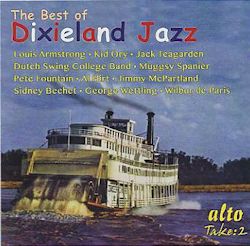1. When the Saints Go Marching In (Teddy Buckner & All Stars, 1955)
2. South Rampart Street Parade (Dutch Swing College Band, 1958)
3. Lazy River (Pete Fountain, 1959)
4. Basin Street Blues (Louis Armstrong and His All Stars, 1957)
5. Muskrat Ramble (Kid Ory and His Creole Jazz Band, 1949)
6. At the Jazz Band Ball (Muggsy Spanier Ragtime Band, 1950)
7. There’ll Be Some Changes Made (Jimmy McPartland and His Dixielanders, 1957)
8. High Society (Jack Teagarden and Don Goldie, 1960)
9. Runnin’ Wild (George Wettling’s All Stars, 1957)
10. Down by the Old Mill Stream (Sidney Bechet, 1957)
11. Willie the Weeper (George Lewis and His New Orleans Music, 1950)
12. Jazz Me Blues (Al Hirt, 1956)
13. Milenberg Joys (Wilbur de Paris, 1951)
14. Way Down Yonder in New Orleans (Dutch Swing College Band, 1960)
15. Bye Bye Bill Bailey (Pete Fountain, 1961)
16. The Faithful Hussar (Louis Armstrong and His All Stars, 1956)
17. Riverboat Shuffle (Jack Teagarden and Don Goldie, 1960)
18. Royal Garden Blues (Kid Ory and His Creole Jazz Band, 1954)
19. After You’ve Gone (George Wettling’s All Stars, 1957)
20. Dippermouth Blues (Muggsy Spanier Ragtime Band, 1956)
21. Tin Roof Blues (Dutch Swing College Band, 1960)
22. Cotton Fields (Pete Fountain, 1957)
23. Shreveport Stomp (Wilbur de Paris, 1952)
24. Sugar (Al Hirt, 1956)
25. Original Dixieland One-Step (Jimmy McPartland and His Dixielanders, 1957)
Joining the long list of “Best of …” albums, this one includes titles that seem to indicate it is aimed at those for whom the term “Dixieland” conjures up
visions of straw hats, striped shirts, and red suspenders. A glance at the play list would suggest that about half or more of them have the attraction that
familiar war horses have for the general public.
The list of performers, however, is impressive. Although a few might be labeled “commercial,” appealing to those who frequent clubs like those on today’s
Bourbon Street in New Orleans, such as Al Hirt and Pete Fountain (who also played in these clubs for long periods), I would not so designate the
others. Die-hard fans of traditional jazz will not quibble with Teagarden, Ory, Spanier, Lewis, et al., although most of the tracks on this CD by those
artists will no doubt be already in these fans’ collections. So here, perhaps, the “Dixieland” of the album’s title refers only to the tunes, rather than
the bands.
Strangely enough the only non-U.S jazz band included is from Holland: the Dutch Swing College Band. (It is also possible that Bechet is backed by some
French musicians, but no personnel are given for most tracks. In Europe in 1957, Bechet played concerts with Buck Clayton, Vic Dickenson, and several other
U.S. musicians, and most likely this track is from a concert in which they all played together.) It would seem to me that since the compiler(s) ventured
outside the U.S. for the bands, at least some of the British bands, such as those of Barber, Colyer, Lyttelton, et al., and also a few other American ones,
such as those of Oliver, Watters, Condon, and Murphy for starters, who are all conspicuously absent, should have been included. Since the title of the CD
imposes no geographic or temporal restrictions, they should be represented, as well as, perhaps, other European bands and those from other parts of the
world—Australia and Japan, for instance. A better compendium would have included such, possibly limiting each group to one track rather than the several
accorded most groups on this CD.
Certainly the disc provides some 76 minutes of good music. Listening to the tracks is akin to listening to an iPod or mp3 player in the shuffle
position—there is no apparent organizing principle here, and as to time periods the selection flits back and forth among the bands, seemingly at random. So
“variety,” it seems, was the aim.
Although most people reading this will already have most of the titles, the CD is priced attractively and should not send anyone to the bank for a loan.
Bert Thompson
